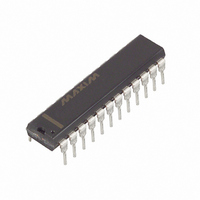DS12C887+ Maxim Integrated Products, DS12C887+ Datasheet - Page 15

DS12C887+
Manufacturer Part Number
DS12C887+
Description
IC RTC W/RAM 128 BYTE 24-EDIP
Manufacturer
Maxim Integrated Products
Type
Clock/Calendar/NVSRAMr
Datasheet
1.DS12885Q.pdf
(22 pages)
Specifications of DS12C887+
Memory Size
113B
Time Format
HH:MM:SS (12/24 hr)
Date Format
YY-MM-DD-dd
Interface
Parallel
Voltage - Supply
4.5 V ~ 5.5 V
Operating Temperature
0°C ~ 70°C
Mounting Type
Through Hole
Package / Case
24-DIP (600 mil) Module
Function
Clock/Calendar/Alarm
Rtc Memory Size
113 Byte
Supply Voltage (max)
5.5 V
Supply Voltage (min)
4.5 V
Maximum Operating Temperature
+ 70 C
Minimum Operating Temperature
0 C
Mounting Style
Through Hole
Rtc Bus Interface
Multiplexed
Lead Free Status / RoHS Status
Lead free / RoHS Compliant
Bit 7: Update-In-Progress (UIP). This bit is a status
flag that can be monitored. When the UIP bit is a 1, the
update transfer occurs soon. When UIP is a 0, the
update transfer does not occur for at least 244µs. The
time, calendar, and alarm information in RAM is fully
available for access when the UIP bit is 0. The UIP bit is
read-only and is not affected by RESET. Writing the
SET bit in Register B to a 1 inhibits any update transfer
and clears the UIP status bit.
Bits 6, 5, and 4: DV2, DV1, DV0. These three bits are
used to turn the oscillator on or off and to reset the
countdown chain. A pattern of 010 is the only combina-
tion of bits that turn the oscillator on and allow the RTC
to keep time. A pattern of 11x enables the oscillator but
holds the countdown chain in reset. The next update
occurs at 500ms after a pattern of 010 is written to DV0,
DV1, and DV2.
The real-time clocks have four control registers that are
accessible at all times, even during the update cycle.
MSB
BIT 7
UIP
BIT 6
DV2
Control Registers
BIT 5
DV1
____________________________________________________________________
BIT 4
DV0
Bits 3 to 0: Rate Selector (RS3, RS2, RS1, RS0).
These four rate-selection bits select one of the 13 taps
on the 15-stage divider or disable the divider output.
The tap selected can be used to generate an output
square wave (SQW pin) and/or a periodic interrupt. The
user can do one of the following:
1)
2)
3)
4)
Table 3 lists the periodic interrupt rates and the square-
wave frequencies that can be chosen with the RS bits.
These four read/write bits are not affected by RESET.
BIT 3
RS3
Enable the interrupt with the PIE bit;
Enable the SQW output pin with the SQWE bit;
Enable both at the same time and the same rate;
or
Enable neither.
Real-Time Clocks
BIT 2
RS2
BIT 1
Control Register A
RS1
BIT 0
RS0
LSB
15











